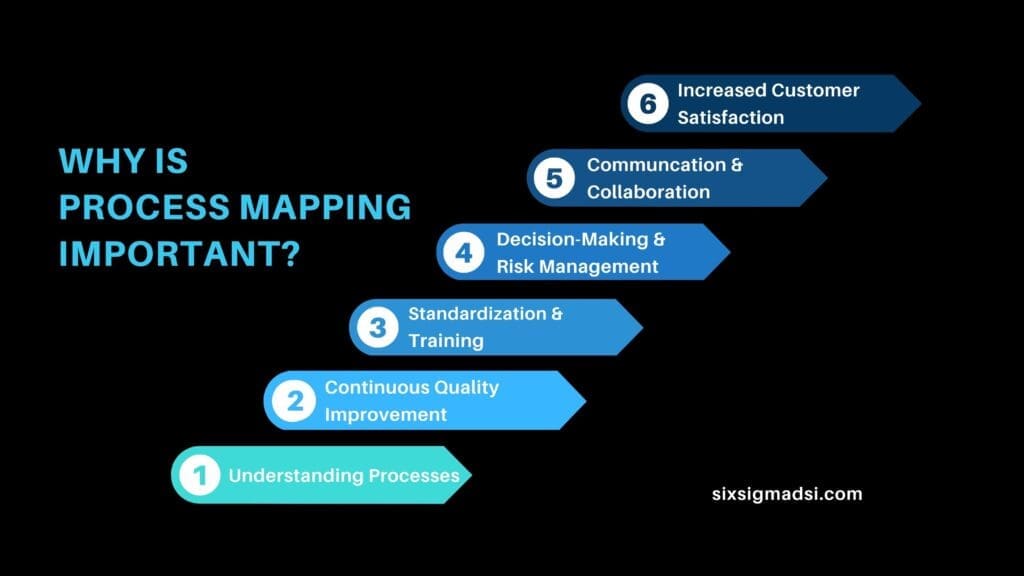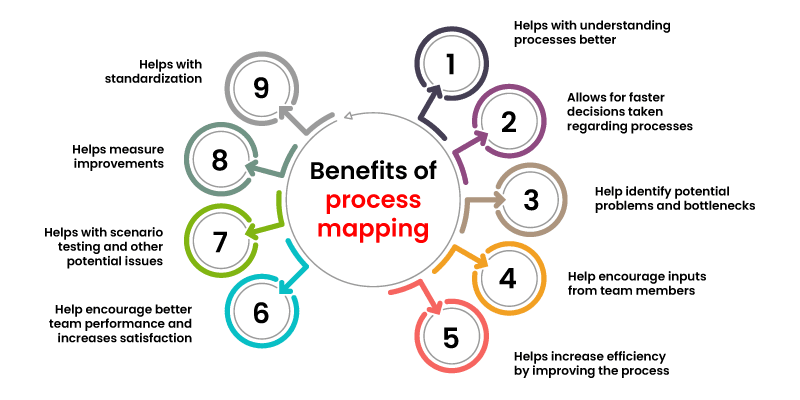Table of Contents
Why is Process Mapping Important?
The main purpose of process mapping is to visually represent and document a process in order to gain a clear understanding of its steps, activities, and interdependencies, fostering understanding, transparency, and the ability to identify opportunities for improvement and optimization within an organization. Process mapping is important for several reasons, particularly in the context of business and organizational management. Here are some key reasons why process mapping is considered valuable:
- Understanding Processes:
- It serves the purpose of creating a clear visual representation of a process, allowing stakeholders to gain insights into the sequence of activities and their interdependencies.
- Identifying Inefficiencies:
- By visually mapping out a process, it becomes easier to identify bottlenecks, redundancies, and other inefficiencies. This understanding is crucial for streamlining processes and optimizing workflows to improve overall efficiency.
- Quality Improvement:
- This tool is instrumental in identifying potential areas for quality improvement. It allows organizations to spot errors, defects, or variations in processes that can impact the quality of the final product or service.
- Standardization:
- Mapping out processes helps in standardizing procedures within an organization. This is particularly important for large organizations with multiple teams or departments to ensure consistency in operations.
- Training and Onboarding:
- They serve as valuable tools for training new employees and onboarding them to existing processes. They provide a clear, visual guide for employees to understand their roles within a broader workflow.
- Communication and Collaboration:
- Process maps facilitate effective communication among team members and between different departments. They provide a common visual language that aids collaboration, making it easier for individuals to work together towards common goals.
- Risk Management:
- Identifying and visually representing processes allows organizations to assess potential risks and vulnerabilities. This proactive approach enables better risk management and helps in developing contingency plans.
- Continuous Improvement:
- Decision-Making:
- Clear process maps provide a basis for informed decision-making. Managers and leaders can analyze the visual representation of a process to make data-driven decisions on improvements, resource allocation, and strategic planning.
- Customer Satisfaction:
- Understanding and optimizing processes can lead to improved customer satisfaction. Streamlining workflows and reducing errors can result in better products or services delivered to customers in a timely manner.
In summary, this is a powerful tool for organizations seeking to improve efficiency, quality, and overall performance. It enables a structured approach to process analysis, fostering continuous improvement and innovation.

Here are Some Examples
Let’s consider an example involving a Quality Management professional and someone who is just starting to learn about process mapping:
Quality Management Professional:
Scenario: Documenting and Improving a Manufacturing Process
A Quality Management professional aims to enhance the quality contcontrol process in a manufacturing facility. They use process mapping for the purpose of documenting and analyzing the current quality control procedures, identifying control points, conducting root cause analysis, proposing improvements, measuring performance, and ensuring continuous monitoring for ongoing enhancements.
Novice Learner:
Scenario: Understanding a Purchase Order Approval Process
A novice learner is tasked with understanding the purchase order approval process. They create a basic process map to identify activity, roles, recognize decision points, ask questions, and provide feedback. This foundational experience helps them gain familiarity with the tool and its application in understanding and improving organizational workflows.
In these examples, the experienced Quality Management professional uses process mapping as a strategic tool to improve a critical manufacturing procedure. In contrast, the novice learner uses process mapping as a foundational step to understand a simpler business process during the early stages of their learning journey. Both instances highlight the versatility of uses in different contexts within an organization.

Purpose in Quality Management and Continuous Improvement
This tool is particularly crucial in the realm of quality management and improvement for several reasons:
- Identifying Quality Issues:
- Process maps provide a visual representation of the entire workflow, making it easier to identify points where quality issues may arise. By understanding the process from start to finish, organizations can pinpoint areas that need improvement to enhance overall product or service quality.
- Root Cause Analysis:
- When quality issues arise, a process mapping activity helps in conducting effective root cause analysis. By visualizing the entire process, teams can trace back issues to their origin and address underlying causes rather than just treating symptoms.
- Standardization of Processes:
- This tool is instrumental in standardizing procedures. Standardization is critical in quality management as it helps ensure consistency, reducing variations that can lead to defects or errors in the final output.
- Continuous Improvement:
- Process mapping is a fundamental part of continuous improvement methodologies like Six Sigma and Lean. It provides a baseline for measuring performance and identifies areas for enhancement, fostering an environment of ongoing quality improvement.
- Efficiency and Effectiveness:
- Mapping out processes allows organizations to assess the efficiency and effectiveness of each step. By streamlining workflows and eliminating unnecessary steps or redundancies, organizations can improve overall efficiency and, consequently, enhance quality.
- Process Control:
- Process mapping aids in establishing control points within a process. These control points enable organizations to monitor and regulate processes effectively, ensuring that they operate within specified quality parameters.
- Employee Training:
- They are valuable tools for training employees on quality standards and procedures. They provide a clear visual guide, making it easier for employees to understand their roles in maintaining and improving quality.
- Risk Management:
- Another key purpose of process mapping is identifying potential risks and vulnerabilities in a process that could impact quality. This proactive approach allows organizations to implement measures to mitigate risks, contributing to better quality management.
- Customer Satisfaction:
- Quality management is closely linked to customer satisfaction. Process mapping helps organizations identify areas where improvements can be made to meet or exceed customer expectations, resulting in higher levels of satisfaction.
- Data-Driven Decision Making:
- Process maps provide a basis for data-driven decision-making in quality management. Leaders can analyze the visual representation of a process to make informed decisions on resource allocation, process optimization, and quality enhancement strategies.
In summary, this is a key tool in quality management and improvement, providing organizations with the insights needed to enhance and improve processes through activities that identify and address quality issues, and ultimately deliver high-quality products or services to customers.
How has process mapping impacted your work or organization?
Are there specific challenges you’ve overcome or successes you’ve achieved through process mapping? Share your experiences in the comments below, and let’s start a conversation about the power of visualizing processes for success!



















